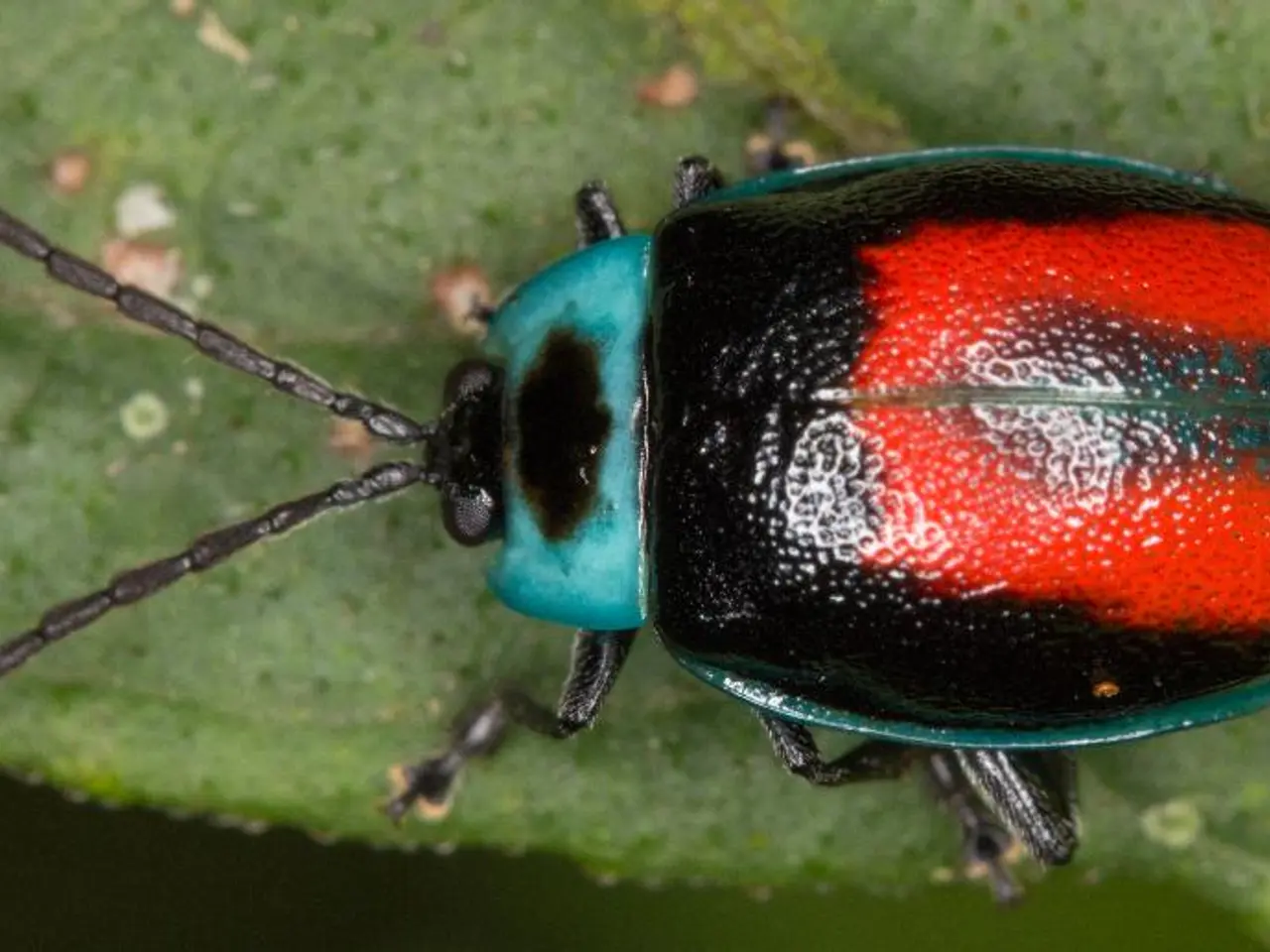Tips for Eliminating Cucumber Beetle Infestations
===========================================================================
Cucumber beetles are a common pest that can wreak havoc on cucurbit plants, including cucumbers, melons, and squash. These yellow-green beetles, with either black spots or black stripes on their backs, are about the size of a cucumber seed and prefer cucurbits like cucumbers and melons [1][3].
These pests can cause significant damage to plants, feeding on the cotyledons, stems, and emerging leaves of young plants in the spring [2]. Worse still, cucumber beetles can carry the pathogen that causes bacterial wilt, a serious disease with no cure. Cucumbers and muskmelons are the most affected of the cucurbits by bacterial wilt [4].
To control cucumber beetles in a vegetable garden, follow these tips:
- Plant later in the season: Delaying planting cucurbits until mid-June helps avoid peak beetle emergence in late spring, reducing damage [5].
- Hand-pick beetles early: Regularly inspect young plants (especially before the third set of true leaves) and remove beetles by squashing or dropping them into soapy water, which helps limit their population [5][2].
- Use yellow sticky traps: Bright yellow traps attract cucumber beetles and can capture them physically [1].
- Encourage natural predators: Attract beneficial insects like ground beetles, which prey on cucumber beetle larvae that pupate in the soil [1].
- Maintain garden cleanliness: Apply a thick layer of mulch to deter egg-laying in soil, pull weeds promptly, remove diseased plants showing bacterial wilt, and clear all garden debris at the season's end to reduce overwintering sites for beetles [5][4].
- Spray insecticidal or insect-killing soap: For substantial infestations, use organic insecticidal soaps or pure Castile soap sprayed directly on beetles for effective control [2].
When beetles infest trap crops like blue Hubbard squash, buttercup squash, or zucchini, it's time to take action. Once a sizable number of beetles shows up on these trap crops, spray the plants with organic pesticides, stuff them into garbage bags, or burn them to dispose of the beetles [3].
Monitor cucurbit plants closely until they grow their third set of true leaves to spot and remove cucumber beetles. Females lay eggs around the base of the host plants, and larvae hatch several weeks later to feed on the roots [1].
Removing weeds and garden debris at the end of the summer reduces shelter for overwintering cucumber beetles. Cucumber beetles that carry the pathogen causing bacterial wilt should be removed immediately to prevent the spread of the disease [5].
By following these tips, you can effectively manage cucumber beetles while minimizing harm to beneficial insects and maintaining garden health.
[1] University of Minnesota Extension. (n.d.). Managing Cucumber Beetles. Retrieved from https://extension.umn.edu/insects/managing-cucumber-beetles
[2] West Virginia University Extension Service. (n.d.). Cucumber Beetles. Retrieved from https://extension.wvu.edu/agriculture/crop-production/cucumber-beetles
[3] Cornell University Cooperative Extension. (n.d.). Cucumber Beetles. Retrieved from https://blogs.cornell.edu/vegetablemd/cucumber-beetles/
[4] University of California Agriculture and Natural Resources. (n.d.). Cucumber Beetles. Retrieved from https://ucanr.edu/sites/PestNote/files/316662.pdf
[5] National Gardening Association. (n.d.). Cucumber Beetles. Retrieved from https://www.gardeningknowhow.com/plant-disease/insects/cucumber-beetles.htm
- In a well-maintained garden, golden flowers attract pollinators like bees, which will help your vegetables, herbs, and numerous other plants thrive.
- Organic gardening is not just about planting vegetables and herbs; it also involves creating a beautiful and functional home-and-garden lifestyle, with decorative garden pieces and a clean, organized design.
- By encouraging natural predators such as ground beetles and other beneficial insects, you can maintain a balance in your garden, helping your planting of flowers, vegetables, and herbs to flourish while reducing the need for chemicals and pesticides.
- To create a healthy and thriving garden, incorporating organic matter into the soil is essential for nourishing plants and promoting microbial life, which in turn encourages the growth of strong roots and healthy foliage in your flowers, vegetables, and herbs.
- gardening not only involves planting vegetables and herbs but also tending to the overall health and appearance of the garden, ensuring that it remains both functional and beautiful, with a focus on attracting pollinators and maintaining a balance of beneficial insects.
- when planning your garden, be sure to consider the spacing between plants, as this will influence how they interact with each other, potentially attracting pests or helping to control them, and overall contributing to the success of your garden full of flowers, vegetables, and herbs.




